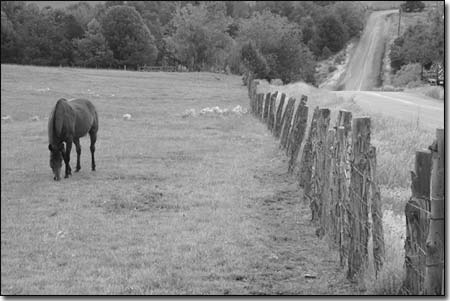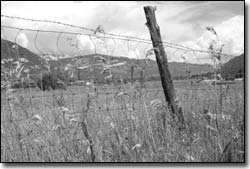|
Public to weigh in on transferable
development rightsby Will Sands
 |
| A horse grazes in a pasture along County Road 301,
southeast of Durango, earlier this week. After more
than 18 months of research
and discussion, a La Plata County transferable development
right (TDR) program is nearly ready to be unveiled.
TDRs could be one
new way of keeping lands such as this free from development.
However, the public will have the final say in whether
the program
pans out./Photo by Todd Newcomer. |
A new tool could help guide the largest growth boom in the Durango area's
history. After more than 18 months of analysis, research and discussion,
a La Plata County transferable development right (TDR) program is nearly
ready to be unveiled. Members of the working group agree that the technique
could be one new way to keep threatened lands free of subdivisions. The
final hurdle will be getting the public to buy in.
On Oct. 20, 2002, the La Plata County commissioners took a breather
from development pressures and voted unanimously to impose a moratorium
on growth in the Grandview area. The move was largely a response to the
Southern Ute Indian Tribe's proposal for more than 2,000 new units immediately
east of Durango. And the moratorium was enacted in part to give county
staffers and a citizens' working group some space to investigate TDRs
as a way of preserving open space before it is too late.
"Durango is booming, let's face it. Either we'll have a creative, multifaceted
approach to growth, or we'll wind up with the sprawl of areas like Grand
Junction," said Tami Graham, a member of the working group and board
member of the Animas Conservancy.
"We do have an active choice."
 |
| Grass grows up along a fence
lining County Road 250 in the
Animas Valley earlier this week. A program being
studied by the
county would preserve open space in “sending” areas
such as this
one outside of town in exchange for higher density
for developers
in “receiving” areas closer to town./Photo
by todd Newcomer. |
As one facet of the approach, TDRs would be the process by which designated
land is preserved by allowing dense development in and around existing
urban areas. Essentially, property rights are voluntarily purchased in "sending
areas," places earmarked as vital open space. Developers then take these
rights to urban "receiving areas" and are given extra units in exchange.
Places targeted for preservation include river corridors, agricultural
land, green belts surrounding urban areas and highway corridors.
"It's not an anti-growth thing," said Graham of the need to preserve
these areas. "When it comes to something like scenic highways, most people
agree that tourism needs to be protected. We don't need a strip mall
from Bayfield to Durango."
The moratorium and its extension have long since expired, and the Southern
Ute Indian Tribe's Three Springs Development is moving on without TDRs.
However, there is widespread agreement that the program could aid in
open space preservation as La Plata County and Durango move into the
future. Mike Preston, the facilitator of the TDR working group, said
that people need to look beyond Three Springs and consider the long-term
potential.
"Even if it takes a while to become functional, you really have to take
the long view and put this in place," he said. "You've got to look at
what having that tool in the tool kit means over the long haul. If a
TDR mechanism had been in place in the Animas Valley 20 years ago, it
could have dramatically changed (the valley's) current appearance."
A tale of two TDRs
TDR programs have mixed track records throughout
the nation. However, there is one area close
to home that's put a different spin on trading
development for open space and seen a great deal
of success. Boulder County began its transferable development
rights program in 1995. Since its inception,
nearly 4,500 acres of land have been preserved
as open space. However, Boulder County also approached
TDRs differently than La Plata County plans to.
"It's a little different than the typical TDR
programs because we don't offer developers an
enormous bonus density," said Peter Fogg, Boulder
County's manager of long-range planning.
In 1995, developers
were required to bring 35 acres to the table
for every one unit they wished to develop.
However, if a developer brought an adequate
number of transferable development rights,
he or she would be allowed three units per
35 acres. The developer also selects the site
to be preserved and then proposes it to county
officials. "We
leave a lot of it up to the developer," Fogg
said. "It was clear that if we designated specific
sites, it would have done bad things to land
values."
After more than eight years of the program,
Fogg said it has been effective but he credited
tighter regulation. In the case of a purely voluntary,
incentive-based system like La Plata County is
proposing, he said it could be more difficult.
"It's kind of a tough one because there's a
fine line between offering it as an additional
option and tightening down the other bolts and
steering developers in that direction," he said. "You
really need to consider offering considerably
higher density. I think it's only realistic that
you're going to have to give a good bonus."
- Will Sands |
Jeanne Trupiano, executive director of the Animas Conservancy, said
that despite appearances and impressions, La Plata County still has a
great deal of open space that needs to be preserved.
"We have so much land that's left even though it feels like it's going," she
said.
One of the biggest appeals of the program is that it is incentive based
and would create a win-win scenario, according to Preston. Developers
could potentially take home higher profits and preserve critical open
space at the same time.
"Combined with other land use tools it gives you a new vehicle," Preston
said. "It is one tool and one appeal of it is that it is incentive based." 4
Trupiano added that any new open space tools are welcome. "I think we
need all the tools we can get," she said. "You have to have some real
strategy and be able to offer alternatives rather than just saying 'no.'"
Flexibility was also deliberately designed into the program, and Graham
said that it is one of its greatest assets.
"I think we need creativity and flexibility because of the diversity
of needs in the community," she said. "We have the agricultural areas,
the urban interface and the river and highway corridors, and they will
all take different approaches."
However, the TDR program has yet to be tested locally, and it could
be a challenging step. Preston noted that placing an incentive-based
approach within a planning context could be one stumbling block.
"It's difficult because you're really meshing a market-based approach
within a regulatory framework," he said. "To make those things work together
is a difficult task."
Kathy Roser, executive director of the La Plata Open Space Conservancy,
added that giving density bonuses to developers could also be a tough
sell.
"I don't know that it's something that will be used a lot if it is implemented," she
said. "You've got to be able to sell it on the basis of fairness."
Plus, Trupiano noted that clustering and density are still not easy
concepts for the residents of La Plata County. "People have to come around
to seeing that clustering isn't that uncomfortable when compared to a
checkerboard of subdivisions," she said.
People will have that opportunity to come around in the approaching
months. Preston said that TDRs should be up for public discussion and
review by early fall. At that point, the program will face its first
major test.
"If the public doesn't like it, it's going to be a goner," Roser said. "If
the public does like it, it could be a new tool for open space."
With the future landscape hanging in the balance, Graham concluded that
the public should give the TDR program a careful look.
"I hope that citizens can withhold judgment until they take a hard look
at this and explore the usefulness of what's being proposed." she said. "It
really does take citizens' involvement to give this kind of thing the
political will it needs."
|